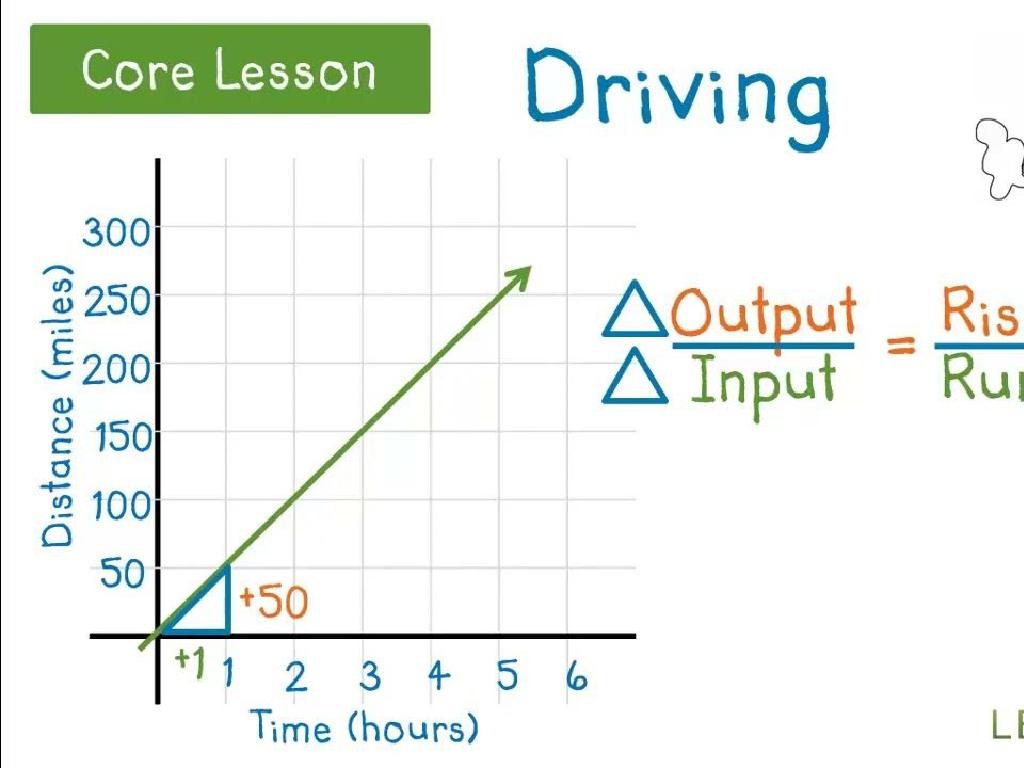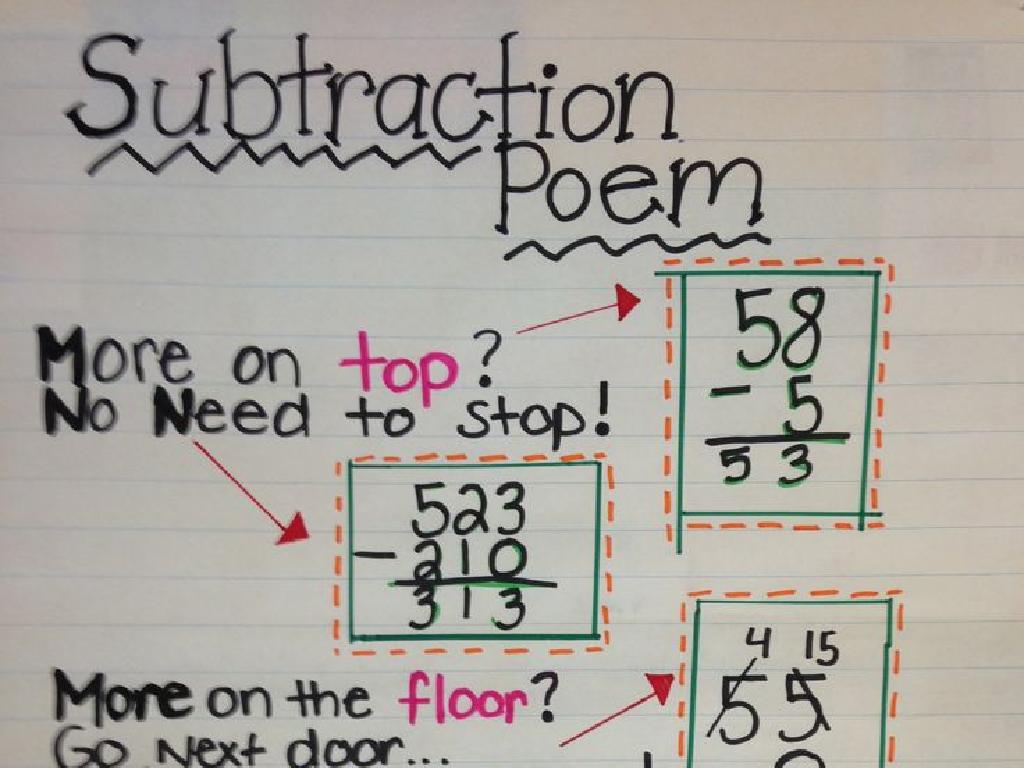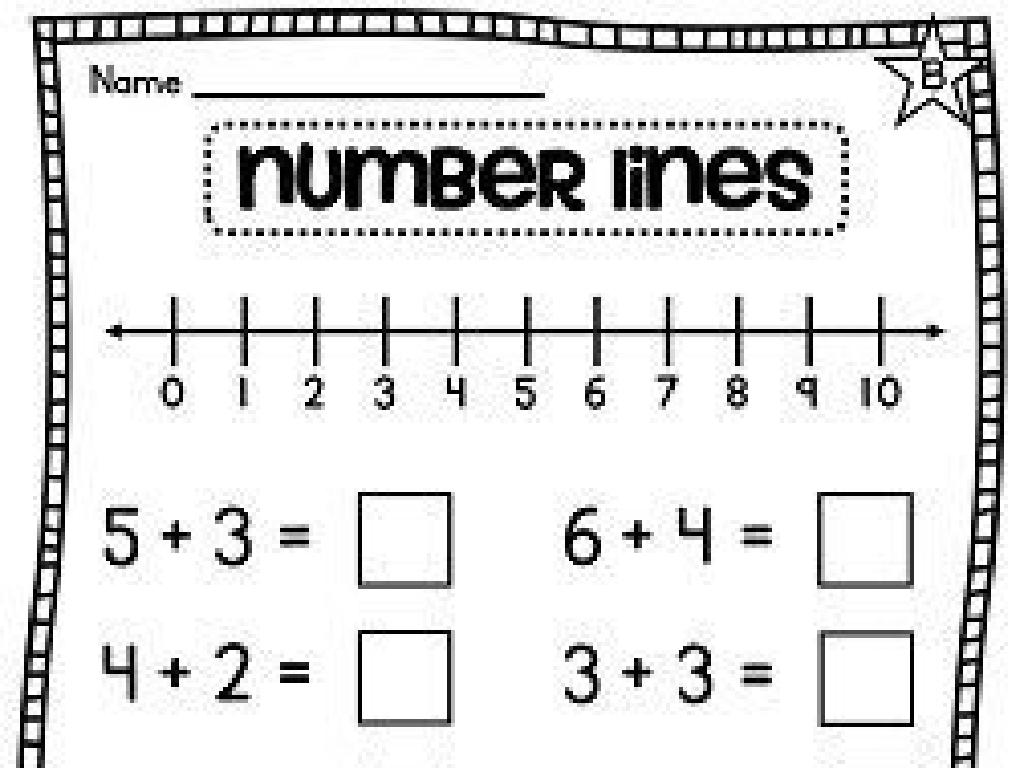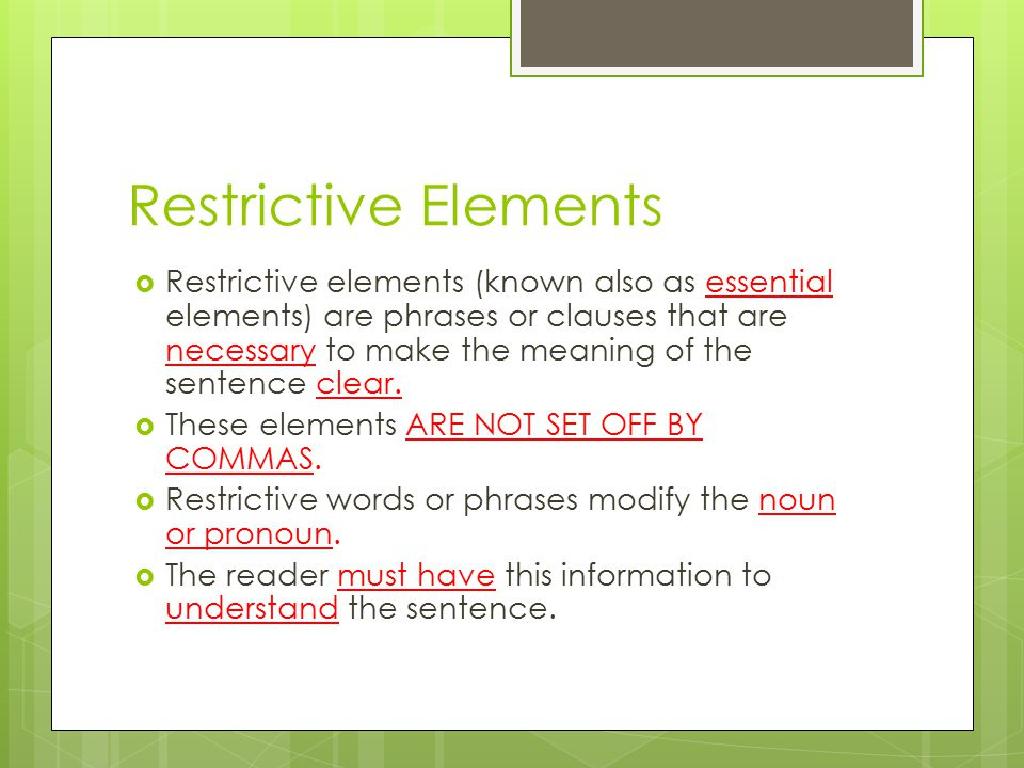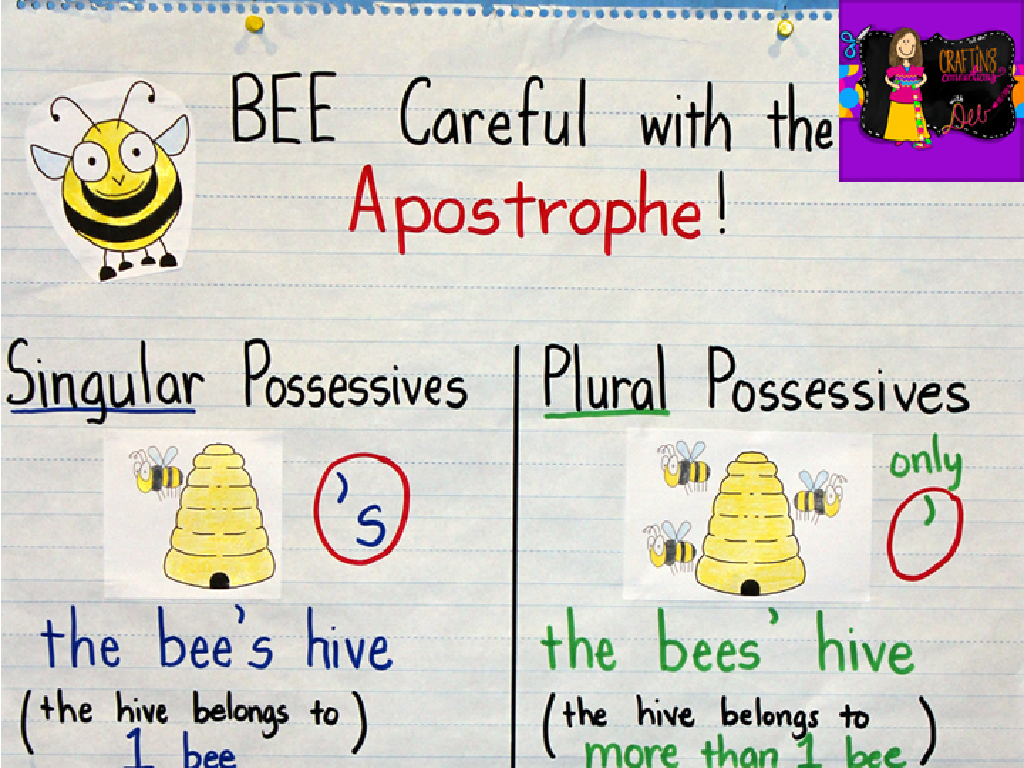Identify Text Structures
Subject: Language arts
Grade: Eighth grade
Topic: Text Structure
Please LOG IN to download the presentation. Access is available to registered users only.
View More Content
Welcome to Text Structures!
– Explore text structure basics
– Text structures are frameworks that writers use to organize information.
– Importance of text structures
– Recognizing structures helps readers follow arguments and retain information.
– Examples of text structures
– For instance, compare/contrast, cause/effect, and sequence/order.
– Impact on comprehension
– Understanding structure improves the ability to analyze and discuss texts.
|
This slide introduces students to the concept of text structures, which are the foundational frameworks authors use to organize information in written works. Emphasize why it’s crucial for students to recognize these structures, as it aids in following the writer’s argument and enhances overall reading comprehension. Provide examples of common text structures such as comparison and contrast, cause and effect, and sequence or chronological order. Discuss how identifying these structures can significantly impact a reader’s ability to analyze, interpret, and discuss the content of a text. Encourage students to look for these structures in their reading assignments and to practice identifying them for better understanding.
Exploring Text Structures
– Define text structure
– The framework of a text’s beginning, middle, and end
– Types: Description
– Descriptive texts paint a picture in the reader’s mind
– Types: Sequence, Cause & Effect
– Sequence: order of events. Cause & Effect: reasons and results
– Types: Compare & Contrast, Problem & Solution
– Compare & Contrast: similarities and differences. Problem & Solution: challenges and responses
|
Text structure refers to how information within a written text is organized. This slide introduces students to the concept and the various types of text structures they will encounter. Description provides sensory details about a topic. Sequence outlines a series of events in the order they occurred. Cause and Effect explains why something happened and the consequences that followed. Compare and Contrast examines the similarities and differences between two or more elements. Problem and Solution presents a challenge and the way it was addressed or could be addressed. Understanding these structures will enhance students’ comprehension and their ability to analyze different texts.
Understanding Description Structure
– Characterizes with detailed descriptions
– Example: Features of a rainforest
– A passage vividly outlining a rainforest’s biodiversity, climate, and layers
– Activity: Find descriptive phrases
– Analyze a paragraph to highlight phrases that create a vivid picture
– Enhances imagery and understanding
|
This slide introduces students to the description text structure, which is marked by detailed imagery and sensory information to help the reader visualize the topic. Use the example of a rainforest to illustrate how descriptive text paints a picture in the reader’s mind, mentioning aspects like the lush greenery, diverse species, and sounds of wildlife. For the activity, provide a paragraph with rich descriptive language and have students identify phrases that serve to describe the subject in detail. This exercise will help them recognize descriptive structures in various texts and enhance their comprehension skills. Encourage students to think about how description makes a text more engaging and informative.
Understanding Sequence Structure
– Sequence structure in texts
– Shows order of events or steps
– Example: Model airplane instructions
– Step-by-step guide, e.g., each stage of construction
– Activity: Organize events sequentially
– Given a story, students will determine the proper sequence of events
|
The sequence structure is a common organizational pattern in writing, particularly useful for explaining processes or narrating events in order. For example, instructions for building a model airplane are typically presented in a sequential manner, guiding the reader through each step in the correct order. In today’s activity, students will practice identifying and arranging events in the correct sequence. This will help them understand how sequence structure can aid in comprehension and clarity of writing. Provide students with a mixed-up series of events from a familiar story or process and ask them to arrange them in the correct order. This activity can be done individually or in small groups to encourage collaboration.
Understanding Cause and Effect in Texts
– Define Cause and Effect structure
– Explains why something happens (cause) and what happens as a result (effect).
– Example: Pollution’s impact on oceans
– Pollution leads to habitat destruction, affecting marine life.
– Activity: Matching causes and effects
– Given scenarios, students will connect causes to their consequences.
– Discuss real-world implications
|
This slide introduces the cause and effect structure, which is crucial for understanding complex texts and real-world issues. Start by defining the structure and discussing its importance in analyzing texts. Use the example of how pollution affects ocean life to illustrate the concept with a real-world issue that resonates with students. The activity involves matching causes with their effects to reinforce learning. Encourage students to think critically about how various actions and events can lead to significant outcomes. This exercise will help them recognize patterns and improve their analytical skills when reading various texts.
Compare and Contrast Text Structure
– Exploring similarities and differences
– Example: Comparing story characters
– Analyze two characters to understand their roles
– Activity: Venn diagram creation
– Choose any two topics from the book and use a Venn diagram to compare and contrast
– Enhances critical thinking
|
This slide introduces the compare and contrast structure, which is used to analyze the similarities and differences between two or more elements. For example, students can compare two characters in a story to understand their roles, motivations, and development. The activity involves creating a Venn diagram, which is an effective visual tool for organizing comparisons. This exercise enhances critical thinking and analytical skills as students must evaluate and articulate the nuances between the chosen topics. Encourage students to think deeply about the characteristics and details that define each element and what they share or how they differ. Provide guidance on selecting appropriate topics and structuring their diagrams for clarity.
Text Structure: Problem and Solution
– Definition: Problem & Solution
– Presents an issue followed by its possible resolutions
– Example: Bullying in schools
– For instance, identifying school bullying and suggesting peer support groups
– Activity: Analyze a text
– Find the problem and solution in the provided passage
– Discuss findings in groups
– Share and compare solutions with classmates
|
This slide introduces the problem and solution text structure, which is commonly used in various forms of writing. Start by defining this structure as one that outlines a problem and then goes on to discuss possible solutions. Use the example of bullying in schools to illustrate how this structure works in practice, discussing the issue and then exploring potential solutions such as peer support groups or anti-bullying campaigns. The activity involves students analyzing a sample text to identify the problem presented and the solutions proposed by the author. After the individual work, students will form groups to discuss their findings, allowing them to see different perspectives and understandings of the text structure. This collaborative effort enhances critical thinking and comprehension skills.
Mastering Text Structures
– Tips for spotting text structures
– Look for keywords, transition words, and the organization of ideas.
– Practice with paragraph analysis
– We’ll analyze sample paragraphs to determine their structure.
– Recognize patterns in texts
– Patterns like cause/effect or problem/solution indicate structure.
– Use clues to identify structure
– Clues like headings and topic sentences help reveal the structure.
|
This slide aims to equip students with strategies to identify various text structures, which is a key component in understanding and analyzing written content. Emphasize the importance of keywords and transition words that signal different structures, such as ‘because’ for cause/effect or ‘similarly’ for compare/contrast. Provide practice opportunities with paragraphs selected from different texts, asking students to analyze and determine the structure used. Highlight common patterns that often correspond to specific structures and teach students to use textual clues like headings, topic sentences, and summary statements to aid in identification. Encourage active participation and discussion during the practice activity to reinforce learning.
Class Activity: Text Structure Scavenger Hunt
– Form small groups for the activity
– Find text structure examples in articles
– Look for description, sequence, cause/effect, compare/contrast, problem/solution
– Present findings to the class
– Discuss the role of structure in comprehension
– How did recognizing the structure aid your understanding?
|
This activity is designed to enhance students’ understanding of text structures by actively engaging them in a scavenger hunt. Divide the class into small groups and provide a selection of articles. Each group’s task is to identify and note examples of the five main text structures: description, sequence, cause and effect, compare and contrast, and problem and solution. After the hunt, each group will present their findings, fostering public speaking and collaboration skills. Conclude with a discussion on how identifying text structures can lead to better comprehension of the material. This will help students recognize patterns in texts and improve their analytical reading skills. Possible variations of the activity could include assigning different structures to different groups or using a variety of texts like essays, textbook excerpts, or news articles.
Conclusion & Homework: Text Structures
– Recap text structure importance
– Homework: Analyze an article
– Choose any interesting article
– Identify the text structure used
– Is it cause/effect, sequence, compare/contrast?
– Explain its impact on comprehension
– How does the structure help understand the article?
|
As we conclude, remind students of the different text structures we’ve covered and their significance in understanding and organizing information. For homework, students should find an article of their choice and write a brief essay. They’ll need to identify whether the text uses comparison, cause and effect, sequence, or another structure and explain how this organization aids in comprehension. This exercise will reinforce their ability to recognize text structures and understand their impact on the reader’s interpretation of content. Encourage students to share their essays in the next class for a collaborative learning experience.

